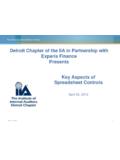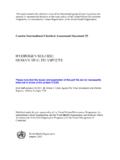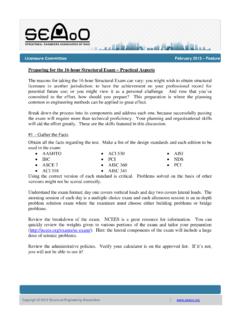Transcription of Tax Aspects of Corporate Mergers and Acquisitions
1 Updated September, 2007 2007, Davis Malm & D'Agostine, Aspects of Corporate Mergers and AcquisitionsWilliam F. Griffin, M. LevDavis, Malm & D Agostine, following outline is intended to acquaint the reader with some of the more important income tax Aspects of merger and acquisition transactions. As with any summary, most of the general statements which follow are subject to numerous exceptions and qualifications. For example, the tax consequences ofa transaction may vary significantly if one or more of the parties is a member of a consolidated group, an S corporation, a foreign corporation, or a tax-exempt organization. You should rely on a more comprehensive treatise for complete and detailed information on this a matter of terminology, the parties to the transactions described in this outline are identified as follows: P means the purchasing or acquiring corporation; S means a wholly-owned Corporate subsidiaryofP; and T means the acquired corporation, or target.
2 SALE OF this transaction, P purchases all of T s stock directly from T s shareholders, in consideration of cash, notes, or some other taxable consideration (or a combination thereof). As a result, T becomes a wholly-owned subsidiaryofP. 1 Seegenerally, Ginsburg & Levin, Mergers , Acquisitions , and Buyouts(2006); Bittker & Eustice, Federal Income Taxation of Corporations and Shareholders(7th ed. 2002); Freund, Anatomy of a Merger(1975); Philips & Rothman, , Structuring Corporation Acquisitions -Tax Aspects (2004); Kling & Nugent-Simon, Negotiated Acquisitio ns of Companies, Subsidiaries and Divisions(2002). s shareholders recognize gain or loss on the sale of their stock, usually capital gain or loss, measured by the difference between the basis in the stock and the purchase price.
3 Generally, individuals are taxed at a 15% rate on capital gainsunder current federal tax law. recognizes no gain or loss on the transaction and its basis in its assets remains s Corporate tax attributes (net operating loss carryovers,etc.) remain unchanged, but may be limited as discussed in Section XIII takes a new tax basis in the T stock purchased from the T shareholders equal to the purchase price paid by P liquidation or merger of T into P following a taxable purchase of 80% or more ofT's stock will ordinarily be tax free. Rev. Rul. 90-95, 1990-2 SALE OF this transaction, T transfers substantiallyall of its assets to P, which may assume none, some, or allofT s liabilities, in consideration of the payment of cash, notes, or some other taxable consideration (or a combination thereof).
4 After the closing, P becomes the new owner of T s assets and any assumed liabilities. T remains in existence immediately after the closing, owning the consideration received for the sale of its assets as well as any assets or liabilities excluded from the sale. T may continue in existence or may be liquidated, in which case its net assets (including the proceeds of sale) are distributed to the T recognizes gain or loss on the sale of its assets, measured by the difference between its basis in those assets and the purchase price (including any liabilities assumed). This gain or loss may be capital or ordinary, depending on the nature of the assets sold. Recapture of depreciation will give rise to ordinary income. ( 1245 and 1250).
5 Sales of 1231 assets (basically depreciable property used in a trade or business and held for more than one year) will give rise to capital gain or ordinary s tax attributes do not carry over to P. However, T s net operating losses will be available to offset gain to T recognized on the takes a new basis in T s assets equal to the purchase price for those assets (including assumed liabilities). purchase price for T s assets is allocated among those assets in accordance with 1060. SeeSection V s shareholders do not recognize gain or loss unless T is T is liquidated, T s shareholders will recognize gain or loss measured by the difference between their tax basis in their stock and the value of the property distributed to them.
6 Thus, there is a double tax on a liquidation: a Corporate level tax on the sale of assets and a shareholder level tax on the distribution of sale merger is the combination of two corporations into one in accordance with state corporation law. Taxable merger transactions can take three basic forms:(a)a directmergerofT into P, with P the survivor. As a result of this transaction, P succeeds to all of T s assets and liabilities and T s shareholders receive cash, notes, or other taxable consideration (or a combination thereof).(b)a forwardtriangularmergerofT into S (a wholly-owned Corporate subsidiaryofP), withS the survivor. As a result of this transaction, S succeeds to all of T s assets and liabilities and T s shareholders receive cash, notes, or other taxable consideration (or a combination thereof).
7 (c)a reversetriangularmergerofS into T, with T the survivor. As a result of this transaction, T becomes a wholly-owned subsidiaryofP and T s shareholders receive cash, notes, or other taxable consideration (or a combination thereof). direct taxable merger will be treated as a taxable sale of assets by T to P, followed by a liquidation of T. Rev. Rul. 69-6, 1969-1 104. The tax consequences to the parties will be as described under Taxable Sale of Assets forward triangular merger will be treated as a taxable sale of assets by T to S, followed by the liquidation of T. The tax consequences will be as described under Taxable Sale ofAssets reverse triangular merger, on the other hand, will be treated as a saleofstockby T s shareholders to P.
8 The tax consequences to the parties will be as described under Taxable Sale of Stock ASSET SALES UNDER SECTION P purchases the stockofT and makes an election under 338, the transaction is treated as a sale of assets by T toitselfat fair market value. ( 338(a)). a result, T recognizes gain or loss on the deemed sale of assets. Since P is the new shareholder of T, P (and not T s former shareholders) bears the economic detriment of the additionaltaxes due by T in the year of will acquire a new basis in its assets equal to the purchase price plus T s liabilities, including any tax liabilities resulting fromthe deemed s tax attributes do not continue, although net operating losses may be applied against anygain on the deemed s shareholders are not affected by the benefit of a 338 election (a stepped-up basis in T s assets) comes at the cost ofimmediate realization of tax on the appreciation in value of those assets.
9 Since the principal benefit of the step-up in basis is only realized over time through depreciation and amortization, there is rarely an advantage to making a 338 RULES FOR ASSET an asset sale transaction, the allocation of the aggregate purchase price among T s assets is of great importance for both T and P. T would prefer to allocate as much of the price as possible to long-termcapital gain items and as little as possible to ordinary income items, recapture items and short-termcapitalgain items. P, on the other hand, would prefer to allocate as much as possible to inventory or items recoverable by depreciation or amortization, and as little as possible to non-depreciable assets, such as statutoryprovisions greatly reduce the parties flexibility in allocating purchase price: the asset allocation rules of 1060and the rules for amortization of intangibles under 197.
10 2 Section 338(h)(10) provides a special election pursuant to which a sale of stock of a corporation which is a member of an consolidated group is treated as though it were an asset sale followed by a liquidation of T. Unlike an ordinary 338 election, the deemed sale takes place while T is still a member of theaffiliated group and the economic consequences of the tax on the appreciated value of T s assets falls on T s shareholder, rather than on P. The benefit of this election has been extended by regulation to S corporations as well. Treas. Reg. (h)(10) -1(c)(1).5 Section 1060 prescribes the so-called residual method for the allocation of purchase price in a taxable asset acquisitio that method, the amount of the purchase price (including assumed liabilities) is allocated in accordance with the following priorities:(a)First, to cashanddemand deposits (Class I assets);(b)Second, to actively traded personal property(such as securities), foreign currency, and certificates of deposit (Class II assets), in an amount equal to their fair market value;(c)Third, toassets that the taxpayer marks to market for income tax purposes(Class III assets),in like manner; (d)Fourth, to stock in trade or inventory of the taxpayer (Class IV assets).










